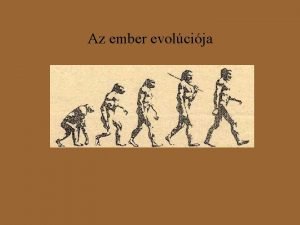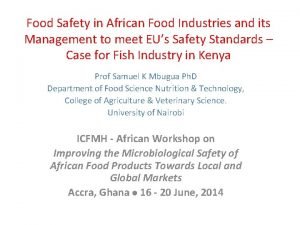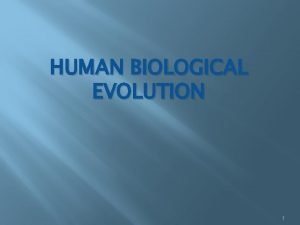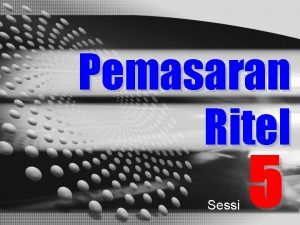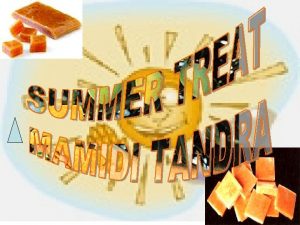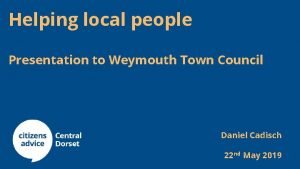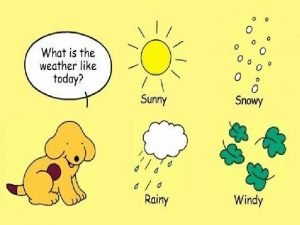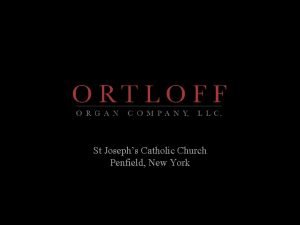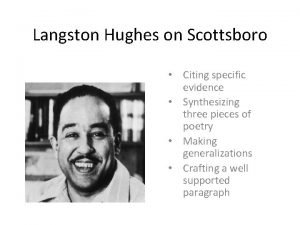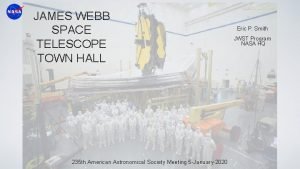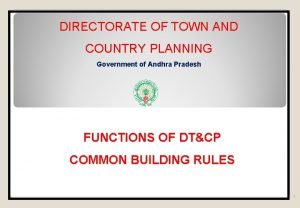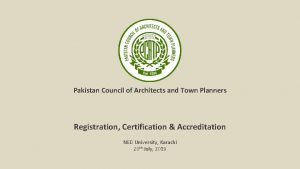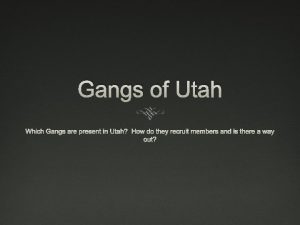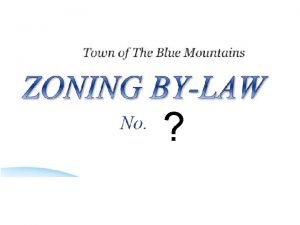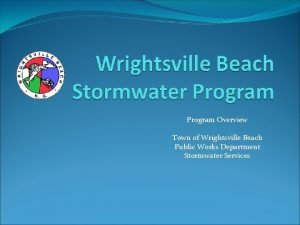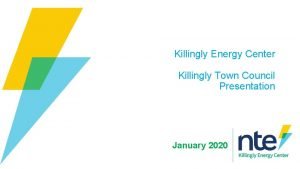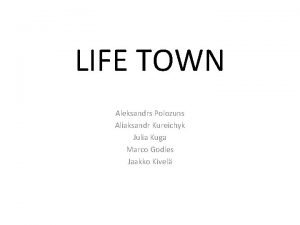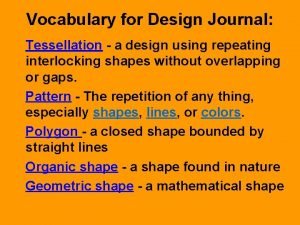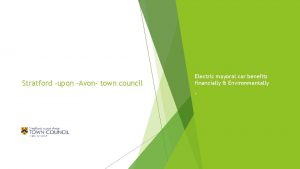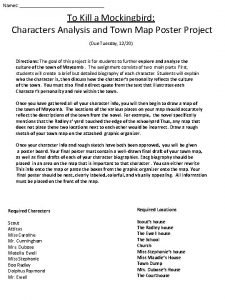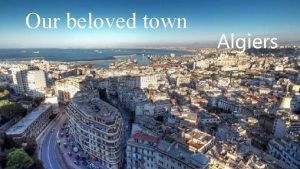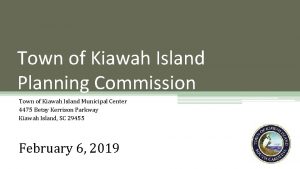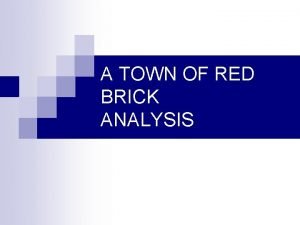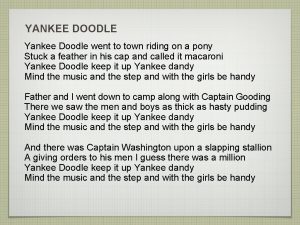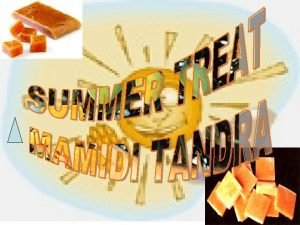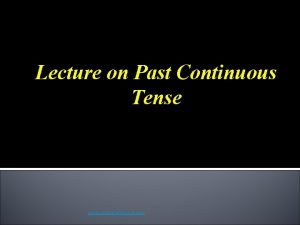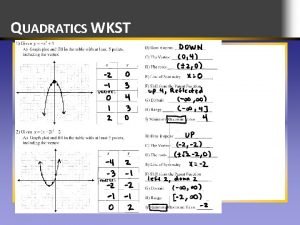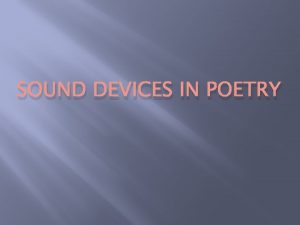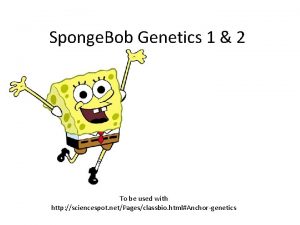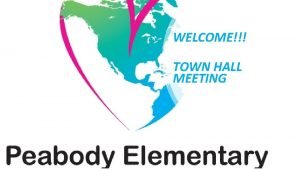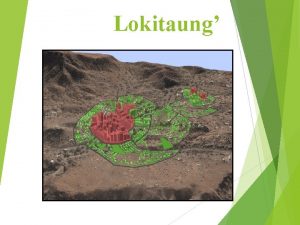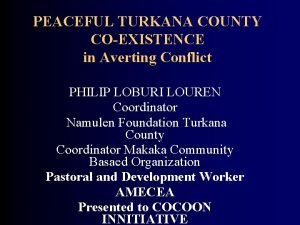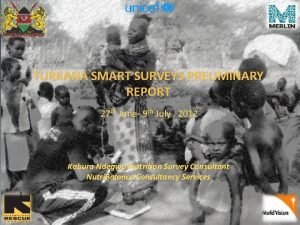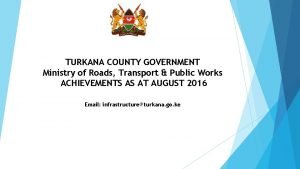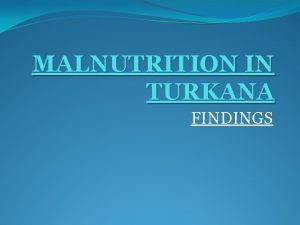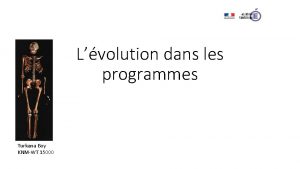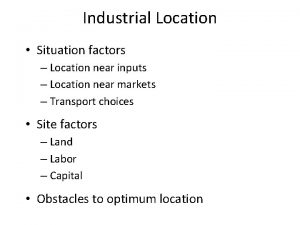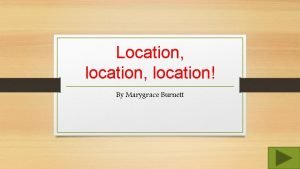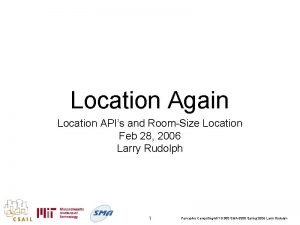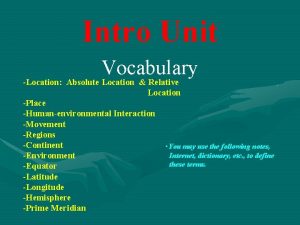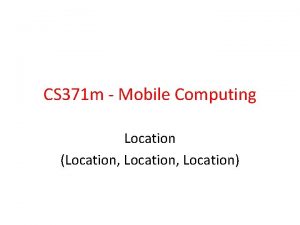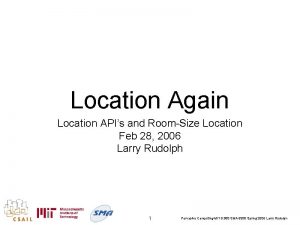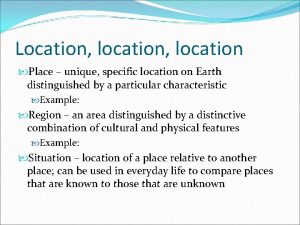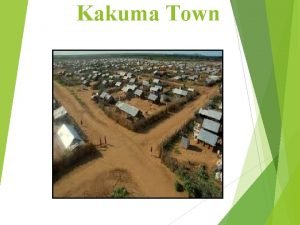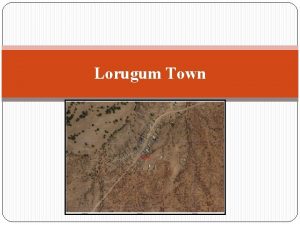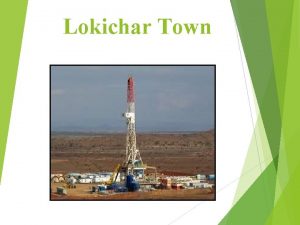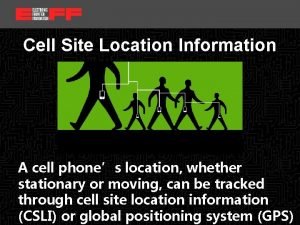LOWARENGAK TOWN LOCATION Lowarengak Town is in Turkana













































- Slides: 45

LOWARENG’AK TOWN

LOCATION Lowareng’ak Town is in Turkana North subcounty along the shores of Lake Turkana Approximately 190 km from Lodwar town. It is located along Longitude 35. 89530 E and Latitude 4. 27690 N at an altitude of 386 metres above sea level.

ISUDP VISION From the stakeholders’ consultations, the vision for Lowareng’ak was agreed to be: “A self-sustaining, eco-friendly, compact town, making Lowareng’ak a World Class fishing Town”.

SITUATIONAL ANALYSIS

EXISTING SITUATION ANALYSIS Physical characteristics & environment: Lowareng’ak falls under arid and semi-arid zones with high temperatures. It experiences an average temperature of 37°C with no rainfall in most parts of the year. • The area receives low rainfall of less than 250 mm per year • The topography of Lowareng’ak town is characterized by flat terrain with laggas • The lagga valleys and the Lake form the natural drainage • Population characteristics: • According to 2009 population and housing census Lowareng’ak town had total a population of 13, 800 people with a total of 2210 number of households and an average household size of 6. .

EXISTING SITUATION ANALYSIS (CONT. ) • The social facilities identified were 1 health facility, 1 secondary schools, 3 primary schools, 4 ECD centres, playing ground which is just open ground without requisite facilities, market that also lack necessary infrastructure, community social hall, and police station. • Transport: The main access road to Lowareng’ak town is D 348 and is consequently the busiest road within the town. There is a total of 19 Km of classified roads in the planning area. The roads have poor drainage and are not maintained regularly. In addition, there are lots of stones and potholes on the road. • The town has an undefined bus park and the main public transport vehicles are pick-ups and vans • Non-motorized transport is not developed within the town. • SWM: no designated garbage collection points.

EXISTING SITUATION ANALYSIS (CONT. ) Water: Lowareng’ak town has 1 borehole located at Mlango area . The water is treated at the source by addition of chlorine into the water. There are currently 173 water connections in the town and 4 water kiosks. The area experiences water shortage and the people travel an average of 1 Km to access water. SWM: The main methods of solid waste disposal include burning in the compound (71. 9 per cent) and designated collection point (18. 8 per cent). The town has an operational solid waste disposal sites. Energy: The major sources of energy for cooking in the area are wood and charcoal which account for 69. 4 per cent. The town has no centralized electrical grid and some residents use private solar panels Settlements: The developments in the planning area mostly comprise of huts in form of manyatta, semipermanent and permanent structures. Land tenure: The land is predominantly under communal Housing: The predominant housing types are huts. The bulk of the houses are semi-permanent with earth being the dominant wall material for the huts and iron sheets for the buildings in the urban center. Economic sector: The economic potential of the town is largely dependent on the proximity of the town to Lake Turkana. The main economic activities are fishing, livestock trade, trading in livestock products, and kiosks and retail shops.

EXISTING LAND USE Land uses: according to the field survey, the largest part of the planning area (64%) is undeveloped, water ways comprise 28. 2% while residential development account for 4. 9% of the land use. The commercial zone has developed along the major road with residential developments developing near it and also near the public purpose developments.

ISSUES IDENTIFIED BY STAKEHOLDERS • Insecurity • Unavailability of water • inadequate health centers • Lack of awareness on land issues • Poor roads • Lack of a market place • Low income levels • Drought • Lack of a public cemetery • Poor communication networks • Poor housing • Poor stakeholder involvement in development matters • Poor planning

SOLUTIONS TO ISSUES IDENTIFIED BY STAKEHOLDERS • Regularizing development • Reinforcing the Physical Planning Department structure • Introduce drought resistant crops such as yams to address issues of food security. • Establish irrigation schemes to solve the food shortage issue. • Public Awareness on ISUDP and development control issues • Upgrading the major roads within the town Generating income from levies, taxes, business permits, user fees, fines and penalties and land rates to fund development projects. • Construct 1 dispensaries to serve the Town, 1 health centre, stadium, fire station and provision of livestock and goods markets, street lighting • Public-private partnerships in housing development •

SECTOR PLAN PROPOSALS

PHYSICAL PLANNING

SPATIAL PLANNING CONSIDERATIONS The process of creating this plan necessitated identifying spatial planning considerations which include: • Major structuring elements: The key structuring elements in Lowareng’ak town include the laggas and major road networks. the major lagga has divided the town into two segments and settlements are mainly concentrated along the major roads • Land availability Land available for urban development in the town is vast. However, with most land held under communal tenure, any alienation of the land to urban development is faced by long procedural issues between the need investors and the community. • Land suitability: About 40 per cent of the planning area is not suitable for development due to the lake, the laggas and the seasonal rivers. • Guiding visions: Vision 2030, Turkana County vision and Stakeholders’ vision • Existing land uses

SPATIAL PLANNING CONSIDERATIONS (CONT. ) • Security: The issue of insecurity cannot be underrated as a significant consideration for planning in Lowareng’ak. The town’s expansion towards the volatile border with Merile from Ethiopia may influence the location of certain urban activities • Environmental consideration: The areas for conservation include the laggas, the riverbeds, the hills and the prevalence of Prosopis Julifora “Etirae” • IDPs: These are considered to be special planning area because of their temporary nature and the spatial planning implications they have in the area.

SPATIAL DEVELOPMENT MODELS The Grid Model The Radial Model

SPATIAL DEVELOPMENT MODELS (CONT. ) The preferred model: Hybrid model in a section of Lowareng’ak CBD This model combines the positive aspects of radial and grid models

STRUCTURE PLAN 8 Broad Zones Conservation areas Public purpose Commercial Residential Land bank Agriculture Lake zone Industrial zone

DETAILED LAND USE PLAN

SOCIAL SECTOR ISSUES • Lack of recreational facilities within the town • Fire outbreaks • Markets lack proper infrastructures and are subject to flooding, critical sanitation problem, security issues and do not have stalls. • The town lack abattoir for livestock • Cemetery not serviced and clearly delineated • Inadequate education facilities • Unevenly distributed education facilities • Inadequate health facilities •

SOCIAL SECTOR DEVELOPMENT ACTIONS Issue Action/program Time Lack of recreational facilities within the Construction of a sports complex/Stadium Short term Cost Actor 60 million TCG town Frequent fire outbreaks Construct a Fire-station Construct buildings and amenities Buy one fire engine Short term 50 million 35 million TCG Buy one fire engine long term 35 million TCG Short term 100 million TCG Markets (Fresh Produce and Sale Yard) Selected investment priorities include: within the town lack proper infrastructures Permanent and are subject to flooding, critical produce market) and drainage (for sanitation problem, security issues and do both) structure (for not have stalls. Fencing The town lacks a slaughterhouse Market street lighting Provision of potable water fresh Delineate and Construct up to standard slaughterhouse to serve the town

SOCIAL SECTOR DEVELOPMENT ACTIONS Issue Action/program Time Cost Actor Cemetery not serviced and clearly delineated Delineate appropriate land for Cemetery Short term 25 million TCG Inadequate education facilities Construct 6 Nursery school to fill current Short term 18 million TCG Unevenly distributed education facilities demand Construct 3 Nursery schools to meet future medium term 9 million demand Construct 3 Primary schools to fill current Short term demand Construct 2 primary schools to meet future medium term 60 million 40 million demand short term construct 1 secondary school Inadequate health facilities Construct 1 Secondary school long term Construct 1 Health centre Short term Construct 2 Dispensaries to serve projected Medium term Short term future demand Construct 1 Sub county hospital 40 million 200 million TCG & GOK

TRANSPORT & INFRASTRUCTURE

PROPOSED TRANSPORTATION PLAN

PROPOSED TRANSPORT NETWORK IMPROVEMENT ACTIVITIES (SHORT-TERM 2021) Road Name Section Length (km) Way leave (m) Current Road condition Activities Required to achieve the projected standard D 348 3 60 Gravel and earth roads Design and construction to tarmac standards C 47 1 60 Gravel and earth roads Design and construction to tarmac standards Arterial Streets Sub Arterial Streets 14. 36 60 Gravel and earth roads Design and construction to tarmac standards 12. 85 45 Gravel and earth roads Opened to gravel and earth standards Collector Streets 9 30 Livestock Corridor 30 20 Local Streets (3. 5 Km) 15 Opened to gravel and earth standards Gravel and earth roads Opened to gravel and earth standards

PROPOSED TRANSPORT NETWORK IMPROVEMENT ACTIVITIES (MEDIUM-TERM 2025) Road Name Section Length Way leave (m) Expected condition at the end of short Activities Required to achieve the projected standard (km) term D 348 3 60 Good maintainable tarmac road with camber. Evaluation of the road condition, design and construction of Drainage and NMT facilities required. trunk road and periodic maintenance by KENHA C 47 1 60 Good maintainable tarmac road with camber. Evaluation of the road condition, design and construction of Drainage and NMT facilities required. trunk road and periodic maintenance by KENHA Arterial Streets 14. 36 60 Good maintainable tarmac road with camber. Evaluation of the road condition, design and construction of Drainage and NMT facilities required. trunk road Sub Arterial Streets 12. 85 45 Gravel and earth roads Collector Streets 9 30 Livestock Corridor 30 20 Local Streets (3. 5 Km) 15 Opened to gravel and earth standards Gravel and earth roads Opened to gravel and earth standards

PROPOSED TRANSPORT NETWORK IMPROVEMENT ACTIVITIES (LONG-TERM 2035) Road Name Section Length Way Expected condition at the end of medium Activities Required to achieve the projected standard (km) leave (m) term D 348 3 60 Good maintainable tarmac road with camber. Evaluation of the road condition, design and routine and Drainage and NMT facilities in place periodic maintenance by KENHA C 47 1 60 Good maintainable tarmac road with camber. Evaluation of the road condition, design and routine and Drainage and NMT facilities in place periodic maintenance by KENHA Arterial Streets 14. 36 60 Good maintainable tarmac road with camber. Evaluation of the road condition, design and routine and Drainage and NMT facilities in place periodic maintenance Sub Arterial Streets 12. 85 45 Good maintainable tarmac road with camber. Evaluation of the road condition, design and routine and Drainage and NMT facilities in place periodic maintenance Collector Streets 9 30 Gravel and earth roads Design and construction to tarmac standards Livestock Corridor 3. 5 20 Gravel and earth roads Opened to gravel and earth standards with adequately spaced watering points and cattle dips. Local Streets 30 15 Gravel and earth roads Design and construction to tarmac standards

INFRASTRUCTURE Water & Sanitation Proposals • Drilling a borehole at Elelea springs and using the water from the Engomo borehole which has already been drilled. • Construction of additional metal storage tanks and installation at Legio village within the town. • Increased piping to the remaining households to cater for the rapidly increasing population. • Use of a hybrid solar powered pump in place of the existing oil powered pump which is unreliable. • Improvement of sanitation facilities can be done by increasing the number of latrines in the town. This will reduce the number of residents who have to resort to bush defecation. • Employing more public health officers and community sensitization. • Provide enough medication and improve the health facilities. Electricity Proposals • Investing in renewable energy such as wind power and solar energy to supply electricity to the town. • Installation of generators to supply electricity to the town. However this is only a temporary solution since power produced by generators is limited and not always reliable.

Telecommunications Proposals • Completion of the construction and implementation of a Safaricom booster • Entice additional mobile network providers to invest in Lowareng’ak town by the County Government offering them subsidized rates to make it profitable to operate in the region. • Promotion of affordable mobile phones and devices to increase their purchase. Solid Waste Management Proposals • Relocate the incinerator far from populated areas to reduce risk of harming residents • Identification of a suitable dumping site. • Empowerment of people to clean the litter in the town. • Formation of groups , register and capacity build on waste management technologies • Identification of waste collection points within the town

TRANSPORT CIP Sector Project Estimated Cost (Kshs) Time-Frame Implementers Short Term Ke. NHA Remarks TRANSPORTATION Road Lowarengak D 348 Road (3 Km) 210 million (70 million/Km) Lowarengak C 47 Road The road requires reconstruction 80 million (80 million/ Km) (1 Km) TCG & KURA The road requires Medium Term TCG & KURA construction 1. 2 billion (40 million/Km) Long Term TCG Bridge 1 100 million Short Term TCG & KURA (200 m) 500, 000/m Bridge 2 200 million (400 m) 500, 000/m Bridge 3 (400 m) Terminals Bridges Arterial Streets (14. 36 Km) 862 million (60 million/Km) Sub-Arterial Streets (12. 85 Km) 642. 5 million (50 million/Km) Collector Streets (9 Km) 405 million (45 million/Km) Local Streets (30 Km) Along collector 1 Medium Term Along collector 5 200 million 500, 000/m Long Term Along collector 10 Bus-station (4000 sqm) 60 million Short Term Parking 2 -Truckparks 10 acres each 100 million Water Jetty 20 million Short Term TCG Ferry Terminal 1 billion Long Term TCG & KFS TCG & KURA Requires terminal facilities & drainage. TCG & KURA

INFRASTRUCTURE CIP Sector Project Estimated Cost (Kshs) Time-Frame Implementers Remarks INFRASTRUCTURE Water Supply Additional boreholes (5 No. ) 25 million & water reticulation TCG & WARMA Medium Term TCG (@Ksh. 5 m) New sand dams (10 No. ) & 100 million pumping/equipment Short Term (@Ksh. 10 m) & Relevant Sewerage & Water Co. &reticulation Water Tanks Provision of storage water 200 million Short Term 20 No. ( 50 m 3 each) Water Treatment Plants Provision of safe potable 500 million Medium Term Centralized Medium Term Along the main Lagga water Sanitation Sewerage Treatment 500 million System 32, 000 m 3/ day Low-rate, anaerobic treatment. Energy Dumpsite 25 million Short Term TCG & NEMA Solar Farms 80 MW 24 billion Long Term TCG & REA & KENGEN (4 MW/ 15 acres) Ksh. 1. 2 billion/4 MW

ENVIRONMENT SECTOR

ENVIRONMENTAL PROBLEM MAP

PROPOSED ENVIRONMENTAL STRATEGIES

ISSUE CHALLENGE AREA STRATEGY PROGRAM/ACTION TIME COST Inadequate environmental management institution Inadequate resources Town wide. Mobilize resources for environmental and natural resource management programmes Development and establishment of environmental and natural resources department. Short term. Ksh 30 TCG, Govt. m (NEMA, KFS, KEFRI, CBOs, NGOs). Short term. Long term Ksh. 100 m TCG, Gazette dumpsite Residents, NEMA, NGOs, CBOs Formulation of Development of urban Long policies and bills forestry programmes term that govern natural resources management e. g. urban forestry Ksh 100 m TCG, KFS, Residents NEMA. Poor Lack of gazetted Built up Identify, designate Provide waste storage management of and designated areas. survey and gazette facilities Solid waste dumpsites and dumpsites Conduct environmental inadequate management tools environmental Community awareness sensitization after among the formation, training and community registration of members. registered group Loss of Informal vegetation cover urbanization Town wide ACTORS COMPLIANCE INDICATORS Environmental and natural resource management, personnel, legal framework, infrastructure and empowerment of stakeholder Landscaping, road side planting, botanical gardens, recreational gardens, riparian protection and tree planting

ISSUE CHALLENGE AREA STRATEGY PROGRAM/ACTIO TIME N COST ACTORS COMPLIANCE INDICATORS Prosopis Juliflora (Etirae) Very fast Town Prosopis Management of growth/ wide management invasive species. colonization & policy and bill. thorns Value chain analysis for prosopis product. Exploitation and utilization Long term Ksh 100 m KFS, KEFRI, NEMA, TCG, CBOs, NGOs, Residents Policy and bill One analysis report Quantities of prosopis product produced Acreage cleared reclaimed, and restored. Flooding Degraded catchment areas Catch Mapping of Allocate resources ment degraded areas. and rehabilitate areas degraded areas in town Long term Ksh 300 m TCG, Central Govt. , Constructed of water harvesting structures, proper water runways drainage system and catchment areas protection. Poverty induced environmental degradation. Low incom e areas in the town Long term Ksh. 50 m TCG, CDF One research report youth & Enhance income womenfund generation and revenue SMEs, CBO s, NGOs, Govt arms Alternative Research on livelihoods and utilization of nonpromote nature wood products based enterprises

ISSUE CHALLENGE AREA STRATEGY PROGRAM/ACTIO N TIME COST ACTORS COMPLIANCE INDICATORS Environmental awareness. Low residents’ Town Enhance environmental wide. environmental awareness. consciousness among town resident. Use electronic and Long print media, posters, term. public meetings, organized sector forums and groups. Ksh. 12 m TCG, More environmental NEMA, consciousness & ethics Environmen among town residents. tal Sectoral actors. Environmental Management tools. Low Town Ensure/promote application of wide application of EIAs, EAs, environmental SEAs& other management environmental tools management tools. Create more awareness on the tools. Monitors & enforce their application where necessary. Short term. Ksh. 2 m NEMA, Number of EIAs, SEAs, TCG, EA reports. Environmen tal sectoral players Drought toll on Town Establish Enhance capacity in Long Human & wide weather stations drought forecasting, term livestock early warning systems, mitigation & adaptations. Ksh. 100 m DMA, TCG, Established weather Dpt. of Met. , stations Min. of Technical reports. specialprogr ams, MENR, Min. of agric& Livestock

ECONOMIC SECTOR

ECONOMIC DEVELOPMENT STRATEGIES Livestock Development Tourism Development The establishment of a formal livestock market The establishment of livestock corridors to control the movement of livestock around the town. These corridors should have watering holes and other similar facilities to encourage pastoralists to use them. Proper waste management around the lake shore to prevent the pollution of lake waters. The development of beach houses to support lake tourism Provision of pesticides and drugs to control for pests and diseases. Improved security, including police patrols along the shore of Lake Turkana. Increased water supply for the livestock. Access to credit facilities by the pastoral communities to be established and existing ones improved Opportunities for value addition such as meat processing, hides and skins processing, handcrafts be established. Market Lowareng’ak as a tourist destination by highlighting its potential for beach and cultural tourism. Finding markets for animal products outside the town. Developing tourist lodges and leisure facilities to support tourism development. Capacity building for livestock producer associations; and Providing veterinary services to maintain the quality of meat and milk products. Developing cultural based artifacts to enhance cultural tourism to generate revenue to locals. Introduce boating facilities and waster sport for tourism promotion. .

Agriculture The introduction of drought resistant crops such as cassavas in the area Public education on proper Small and Medium Development of farm inputs such as fertilizers and pesticides Building water catchment areas such as dams to support agricultural activities during droughts (SMEs) Increase electric connectivity in the area for higher accessibility by businesses. Decentralization of the issuance of business permits/licences from Lodwar to Lowareng’ak to lower the cost of establishing businesses. Issuance of single business permits. Beefing up security in the town to enhance investor confidence. Construction of access roads from the main roads to enhance accessibility to business enterprises. Ensuring there is enough serviced land for business needs by clearing needs and availing land for business establishments. Increasing access to finance by providing credit facilities to SMEs with inadequate or no collateral. farming methods in the area. Provision Enterprises

Fishing Regulating fishing activities within Lake Turkana to ensure sustainable fishing activities. Creating a market for fish within the town Construction of roads and other necessary infrastructure to Proposals for Income Generation for TCG Levies and Taxes market accessibility Licenses and Business Permits Building a fish processing plant with advanced preservation User Fees Revenues from doing business Fines and penalties Tourism proceeds Land rates support the development of the fishing trade and increase technologies such as cooling to increase the shelf-life of fish. Ferrying fish to other towns and cities to expand the market. Assisting the fishermen at Lowareng’ak to create co-operatives Provide education to make the local population change their attitudes towards fishing and fish consumption. Enforcement of fisheries regulations so as to protect the yield potential of the fish

SUMMARY OF CAPITAL INVESTMENT PLAN

SUMMARY OF ESTIMATED TOTAL COSTS PER SECTOR i. Transport sector Short term: KES 1. 682 billion Medium term: KES 2. 4475 billion Long term: KES 31. 4 billion Overall total 35. 5295 billion ii. Social sector Short term: KES 708 million Medium term: KES 69 million Long term: KES 75 million Overall total 852 million iii. Environmental sector The investment for environmental infrastructure which is 794 million will be able to cover the town for the whole planning period Grand Total (i, ii and iii) 37. 1755 Billion

COMMUNITY PARTICIPATION AND PROJECT IMPLEMENTATION MODEL • • • The implementation of the ISUDPs for the Turkana towns should be done while involving local communities. The implementation process should commence with project ranking to identify priority projects during the implementation phase. Community members should be involved in the identification of priority projects in the respective towns. The County Government should then secure development financing from sources such as the national government, international organisations/donors, private entities, and internal revenue sources. Adequate fiduciary controls on the use of project funds should be put in place before the commencement of the project.

COMMUNITY PARTICIPATION AND PROJECT IMPLEMENTATION MODEL Procurement of goods, works and services should follow. Environmental and social impact mitigation strategies should be set out. • Project implementation committees should be formed to monitor the progress of the projects being implemented. • Committee membership should be comprised of community members and technical persons. • The project implementation committees should prepare biannual implementation status and results reports for effective monitoring and evaluation of project implementation. • •

EJOK NOI ASANTE THANK YOU
 Lowarengak
Lowarengak Turkanai fiú
Turkanai fiú Lake turkana fish processing plant
Lake turkana fish processing plant 69
69 Sin values
Sin values Retail location adalah
Retail location adalah A cross country skier moves from location a to location b
A cross country skier moves from location a to location b In location planning the location of raw materials
In location planning the location of raw materials Chittibabu and chinnababu
Chittibabu and chinnababu Public buildings in pompeii
Public buildings in pompeii Weymouth town council
Weymouth town council Ghost 7 letters
Ghost 7 letters St joseph penfield
St joseph penfield Justice by langston hughes analysis
Justice by langston hughes analysis Jwst town hall
Jwst town hall Directorate of town & country planning
Directorate of town & country planning Mono internet
Mono internet Babytown frolics
Babytown frolics Pcatp
Pcatp Diploetic
Diploetic Utah nortenos
Utah nortenos Kien thuc ngay nay is one of the most popular
Kien thuc ngay nay is one of the most popular Collingwood bylaw
Collingwood bylaw Wrightsville beach public works
Wrightsville beach public works Killingly energy center
Killingly energy center Kuga town
Kuga town Tessellation town
Tessellation town Stratford upon avon town council
Stratford upon avon town council To kill a mockingbird town map
To kill a mockingbird town map Beloved town
Beloved town Town of kiawah island
Town of kiawah island Scp 000
Scp 000 Coketown was a town of red brick
Coketown was a town of red brick Yankee doodle went to town riding on a pony
Yankee doodle went to town riding on a pony Chittibabu and chinnababu live in
Chittibabu and chinnababu live in My brother and sister playing tennis at 11am yesterday
My brother and sister playing tennis at 11am yesterday A town has a nature preserve with a rectangular field
A town has a nature preserve with a rectangular field Fleetwood town fc academy
Fleetwood town fc academy Anyone lived in a pretty how town literary devices
Anyone lived in a pretty how town literary devices Sedgefield town council
Sedgefield town council In the dark dark town
In the dark dark town Huntersville town billboards
Huntersville town billboards Describe lee coker and amos hicks
Describe lee coker and amos hicks Patrick met patti at the dance
Patrick met patti at the dance Once upon a time there lived a number of mice in a house
Once upon a time there lived a number of mice in a house Peabody town hall
Peabody town hall

